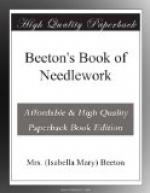* * * * *
[Illustration: 205.—Lappet or Sash End in Venetian Embroidery.]
205.—Lappet or Sash End in Venetian Embroidery.
Materials: Messrs. Walter Evans and Co.’s
embroidery cotton No. 6 and
No. 12; net and muslin.
The pattern must first be traced on muslin, which is then tacked over net. The outlines are worked in button-hole stitch, and the veinings are sewn over, using the coarse cotton for tracing; the muslin is then cut away all round the pattern.
* * * * *
206.—Venetian Border.
Materials: Messrs. Walter Evans and Co.’s
embroidery cotton No. 12 and
No. 16; net and muslin.
[Illustration: 206.—Venetian Border.]
This design is elegant and effective, without there being a great deal of work in it. It is useful for tuckers for evening dresses or handkerchief borders. The muslin is laid over the net, sewn neatly over, and then cut away between the pattern, leaving the net for the ground work.
[Illustration: 207.—Lace Insertion.]
* * * * *
207.—Lace Insertion.
Materials: Fine black sewing silk; black Brussels net.
This lace insertion is first outlined in running stitch upon the net; the leaves are then darned across the net holes; the stems are worked in overcast stitch; the dots are embroidered by darning across the circle previously outlined; the lace stitches in the centre are formed by gently enlarging the net holes with a fine stiletto, and then sewn lightly round, the remaining holes being filled with lace stitches consisting of fine button-hole stitches, very evenly worked over the entire space surrounding the open holes.
To be effective the very finest black silk should be employed. This pattern may be worked in applique by placing muslin over net, sewing all the outlines in fine overcast stitch, and when finished, carefully cutting away the muslin.
* * * * *
208 and 209.—Slipper on Java Canvas.
Materials: Light brown Java canvas; green silk; green filoselle and purse silk; green silk ribbon three-fifths of an inch wide; some wadding; 2 cork soles.
[Illustration: 208.—Slipper on Java Canvas.]
This slipper is very pretty, and easy to work. It is made of light brown Java canvas, and embroidered in point Russe with green filoselle. It is lined with green silk, and slightly quilted. The soles are of cork. The slipper is trimmed all round with a ruche of green silk ribbon three-fifths of an inch wide, pleated in double box pleats. The heel is turned down inside. No. 209 shows the pattern of the point Russe stitch nearly full size.
[Illustration: 209.—Point Russe Stitch for Slipper (No. 208)]
* * * * *




